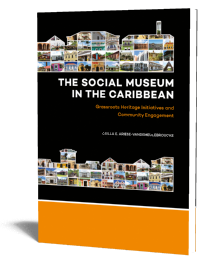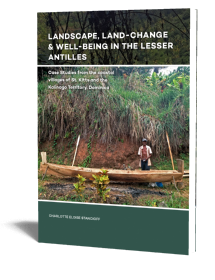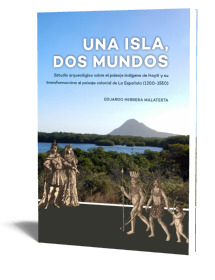Indigenous Ancestors and Healing Landscapes
Cultural Memory and Intercultural Communication in the Dominican Republic and Cuba
Jana Pešoutová | 2019

Indigenous Ancestors and Healing Landscapes
Cultural Memory and Intercultural Communication in the Dominican Republic and Cuba
Jana Pešoutová | 2019
Paperback ISBN: 9789088907647 | Hardback ISBN: 9789088907623 | Imprint: Sidestone Press Dissertations | Format: 182x257mm | 364 pp. | NEXUS 1492 | Language: English | 13 illus. (bw) | 73 illus. (fc) | Keywords: healing traditions, Cuba, Dominican Republic, cultural memory, sacred landscape, healing plants, medicinal history, politics of memory, representation of the past, indigenous people of the Caribbean, Caribbean religions | download cover
Read online or downloaded 598 times
-
Digital & Online access
This is a full Open Access publication, click below to buy in print, browse, or download for free.
-
Buy via Sidestone (EU & UK)
-
Buy via our Distributors (WORLD)
For non-EU or UK destinations you can buy our books via our international distributors. Although prices may vary this will ensure speedy delivery and reduction in shipping costs or import tax. But you can also order with us directly via the module above.
UK international distributor
USA international distributor
-
Bookinfo
Paperback ISBN: 9789088907647 | Hardback ISBN: 9789088907623 | Imprint: Sidestone Press Dissertations | Format: 182x257mm | 364 pp. | NEXUS 1492 | Language: English | 13 illus. (bw) | 73 illus. (fc) | Keywords: healing traditions, Cuba, Dominican Republic, cultural memory, sacred landscape, healing plants, medicinal history, politics of memory, representation of the past, indigenous people of the Caribbean, Caribbean religions | download cover
Read online or downloaded 598 times

We will plant a tree for each order containing a paperback or hardback book via OneTreePlanted.org.
This book presents new interpretations of current healing practices in Cuba and the Dominican Republic juxtaposed against the European colonization of the Caribbean after 1492. By combining data from critical historical analyses and ethnographic fieldwork, this research examines current healing landscapes and their historical background in both countries.
This dissertation situates the continuous importance of non-institutional healing practices within the rich symbolism of Cuban and Dominican landscapes. More specifically, the study focuses on practices promoting physical, mental and spiritual healing of individuals and communities. It provides various examples that illustrate human interactions with divine and ancestral beings residing in places such as water sources, caverns, or manifested in plants and other natural phenomena. Data presented in this work guides our understanding of how local cultural memory plays a key role in our construction of medicinal histories, and the profound demographic and landscape transformations which shaped the healing landscapes after European conquest. Healing landscapes are also testimonies of the Cuban and Dominican ancestors’ creativity, resilience, capacity to heal and find unity in the dehumanizing and alienating atmosphere of colonial violence and exploitation. This book is not aimed solely for academic public, but also those interested in Caribbean cultures, and the history of medicinal practices.
1. Rhizomes of Healing Landscapes
Colonial discourse and the question of cultural continuity
Forgetting indigenous peoples of the Greater Antilles
Approaching Healing Landscapes
Data collection and fieldwork methodology
Ethics
Outline of the dissertation
PART I: THEORETICAL AND HISTORICAL DIMENSIONS OF CARIBBEAN LANDSCAPES
2. Healing Landscapes from a theoretical perspective
Introduction to landscape studies
Memory landscapes
Healing Landscapes
3. Natural Man in the Caribbean Paradise: the origins of colonial discourse
The noble savage idea in Lesser Antilles
Indigenous past as the beginning of the Dominican nation
Indigenous ancestors during the formation of the Cuban nation
The indigenous past in Dominican and Cuban History textbooks
The Alienation from Natural Man in the collective memory
4. Empty Pages in the Biography of Healing Landscapes
Indigenous ancestors transforming Caribbean Landscapes
West African ancestors shaping Caribbean landscapes
European ancestors reshaping Caribbean landscapes
The multidirectional circulation of the medicinal knowledge in the Greater Antilles
Concluding remarks
5. Crossroads of Cultural landscapes: the indigenous base of demographic changes
Brief account of indigenous ancestors in colonial Hispaniola
African ancestors in Dominican demographic history
The interactions among the colonized strata
The subsequent historical development of Dominican society
A brief overview of demographic background of selected Dominican sites
Major tendencies in Cuban ethnogenesis
Colonial history of Indigenous Cuban ancestors
African ancestors in Cuban ethnogenesis
Distinctive character of the demographic history of the eastern Cuba
A brief overview of demographic background of selected Cuban sites
Revising the indigenous component in demographic histories
PART II: CONTEMPORARY TRADITIONS
6. Qualities of the landscape in daily life
Flora as a source of alimentation
Concluding remarks
7. Healing in sacred and animated landscapes
Other spiritual beings in Cuban and Dominican landscapes
Illness and cure
Healing specialists
Healing Plants
Ancestral roots and rhizomes
Concluding remarks
8. The subaquatic realm of ancestors and other beings
Dominican Ancestral Subaquatic Dwellings
Caribbean waterbodies as reservoirs of indigenous past
Concluding remarks
9. Re-membering ancestors in caves
Mana Landscape
Cave of La Mancha: Healing with Indigenous Lwas
The Cave of Saint Francis as a Healing and Memory Place of Bánica
Healing among Spiritists, Managuaco cavern, Holguín, Cuba
Cueva De los Santos Gibara, Cuba
Cuban and Dominican caverns as memory places of indigenous past
Concluding remarks
10. Synthesis and Conclusions. At the Crossroads of Healing Landscapes
Remembrance and Oblivion
Historical formation of Cuban and Dominican Medicinal Cultures
Constituents of healing landscapes
Memory of indigenous ancestors
Water sources and caves as ancestral places
Healing landscapes as expressions of cultural memories of indigenous past
Continuities and heritage loss
Healing landscapes within landscape theories
Future directions of research
Bibliography
Abstract
The research and its objectives
Acknowledgments
Attachment

Dr. Jana Pešoutová
Jana Pešoutová was born in Český Brod, Czech Republic in 1987. After obtaining her bachelor’s degree in applied linguistics at Palacký University in Olomouc in 2010, she moved to the Netherlands where she completed her Master in the Management of Cultural Diversity. Drawing on theories from social psychology, her master’s thesis focused on the impact of the social exclusion and its relationship with extremism among the youth. From 2013 she carried out her doctoral research as a part of the 1492 Nexus project at Faculty of Archaeology, Leiden University, The Netherlands.
Abstract:
This book presents new interpretations of current healing practices in Cuba and the Dominican Republic juxtaposed against the European colonization of the Caribbean after 1492. By combining data from critical historical analyses and ethnographic fieldwork, this research examines current healing landscapes and their historical background in both countries.
This dissertation situates the continuous importance of non-institutional healing practices within the rich symbolism of Cuban and Dominican landscapes. More specifically, the study focuses on practices promoting physical, mental and spiritual healing of individuals and communities. It provides various examples that illustrate human interactions with divine and ancestral beings residing in places such as water sources, caverns, or manifested in plants and other natural phenomena. Data presented in this work guides our understanding of how local cultural memory plays a key role in our construction of medicinal histories, and the profound demographic and landscape transformations which shaped the healing landscapes after European conquest. Healing landscapes are also testimonies of the Cuban and Dominican ancestors’ creativity, resilience, capacity to heal and find unity in the dehumanizing and alienating atmosphere of colonial violence and exploitation. This book is not aimed solely for academic public, but also those interested in Caribbean cultures, and the history of medicinal practices.
Contents
1. Rhizomes of Healing Landscapes
Colonial discourse and the question of cultural continuity
Forgetting indigenous peoples of the Greater Antilles
Approaching Healing Landscapes
Data collection and fieldwork methodology
Ethics
Outline of the dissertation
PART I: THEORETICAL AND HISTORICAL DIMENSIONS OF CARIBBEAN LANDSCAPES
2. Healing Landscapes from a theoretical perspective
Introduction to landscape studies
Memory landscapes
Healing Landscapes
3. Natural Man in the Caribbean Paradise: the origins of colonial discourse
The noble savage idea in Lesser Antilles
Indigenous past as the beginning of the Dominican nation
Indigenous ancestors during the formation of the Cuban nation
The indigenous past in Dominican and Cuban History textbooks
The Alienation from Natural Man in the collective memory
4. Empty Pages in the Biography of Healing Landscapes
Indigenous ancestors transforming Caribbean Landscapes
West African ancestors shaping Caribbean landscapes
European ancestors reshaping Caribbean landscapes
The multidirectional circulation of the medicinal knowledge in the Greater Antilles
Concluding remarks
5. Crossroads of Cultural landscapes: the indigenous base of demographic changes
Brief account of indigenous ancestors in colonial Hispaniola
African ancestors in Dominican demographic history
The interactions among the colonized strata
The subsequent historical development of Dominican society
A brief overview of demographic background of selected Dominican sites
Major tendencies in Cuban ethnogenesis
Colonial history of Indigenous Cuban ancestors
African ancestors in Cuban ethnogenesis
Distinctive character of the demographic history of the eastern Cuba
A brief overview of demographic background of selected Cuban sites
Revising the indigenous component in demographic histories
PART II: CONTEMPORARY TRADITIONS
6. Qualities of the landscape in daily life
Flora as a source of alimentation
Concluding remarks
7. Healing in sacred and animated landscapes
Other spiritual beings in Cuban and Dominican landscapes
Illness and cure
Healing specialists
Healing Plants
Ancestral roots and rhizomes
Concluding remarks
8. The subaquatic realm of ancestors and other beings
Dominican Ancestral Subaquatic Dwellings
Caribbean waterbodies as reservoirs of indigenous past
Concluding remarks
9. Re-membering ancestors in caves
Mana Landscape
Cave of La Mancha: Healing with Indigenous Lwas
The Cave of Saint Francis as a Healing and Memory Place of Bánica
Healing among Spiritists, Managuaco cavern, Holguín, Cuba
Cueva De los Santos Gibara, Cuba
Cuban and Dominican caverns as memory places of indigenous past
Concluding remarks
10. Synthesis and Conclusions. At the Crossroads of Healing Landscapes
Remembrance and Oblivion
Historical formation of Cuban and Dominican Medicinal Cultures
Constituents of healing landscapes
Memory of indigenous ancestors
Water sources and caves as ancestral places
Healing landscapes as expressions of cultural memories of indigenous past
Continuities and heritage loss
Healing landscapes within landscape theories
Future directions of research
Bibliography
Abstract
The research and its objectives
Acknowledgments
Attachment

Dr. Jana Pešoutová
Jana Pešoutová was born in Český Brod, Czech Republic in 1987. After obtaining her bachelor’s degree in applied linguistics at Palacký University in Olomouc in 2010, she moved to the Netherlands where she completed her Master in the Management of Cultural Diversity. Drawing on theories from social psychology, her master’s thesis focused on the impact of the social exclusion and its relationship with extremism among the youth. From 2013 she carried out her doctoral research as a part of the 1492 Nexus project at Faculty of Archaeology, Leiden University, The Netherlands.
-
Digital & Online access
This is a full Open Access publication, click below to buy in print, browse, or download for free.
-
Buy via Sidestone (EU & UK)
-
Buy via our Distributors (WORLD)
For non-EU or UK destinations you can buy our books via our international distributors. Although prices may vary this will ensure speedy delivery and reduction in shipping costs or import tax. But you can also order with us directly via the module above.
UK international distributor
USA international distributor
- Browse all books by subject
-
Search all books

We will plant a tree for each order containing a paperback or hardback book via OneTreePlanted.org.
You might also like:
© 2025 Sidestone Press KvK nr. 28114891 Privacy policy Sidestone Newsletter Terms and Conditions (Dutch)








